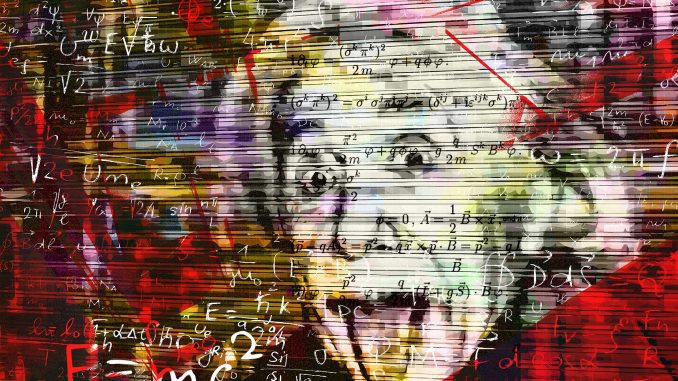Reading Time – 10 minutes, Difficulty Level 5/5
I’ve chosen to classify this piece as a 5/5 difficulty level because of the maths in it, which isn’t difficult maths in isolation but the accumulation requires a little concentration to take onboard fully.
Okay, let’s dive in.
Many people don’t understand just how much energy there is in regular matter. The nucleus of any atom (atoms make up all matter) is an oven of intense radiation, and when you open the oven door, that energy spills out; often violently. However, there is even more to this aspect of matter. Something that baffled the greatest scientists for years.
It wasn’t until the brilliance of Albert Einstein that we were able to fully understand the correlation between mass and energy. Enter E=mc2. This seemingly simple algebraic formula represents the correlation of energy to matter (energy equivalence of any given amount of mass).
Lots of us have heard of it, but not very many can understand exactly what Einstein was telling us with it.
So, for the next few minutes, let’s attempt to understand the magnitude of our own personal potential energy equivalence.
The bits and bobs

First, we must break down this equation. What do each of the letters mean? What are their values? Let’s break it down from left to right:
E represents the energy, which we measure in Joules. Joules is an SI (International System of Units) measurement for energy and is measured as kilograms multiplied by metres squared per seconds squared [kg x m2/s2]. All this really means is that a single Joule of energy is equal to the force used to move a specific object 1 metre in the same direction as the force.
m represents the mass of the specified object. For this equation, we measure mass in Kilograms (1000 grams).
c represents the speed of light. In a vacuum (such as space), light moves at 186,282 miles per second. However in science we utilise the aforementioned ‘SI’ (International System of Units), therefore we use measurements of metres and kilometres as opposed to feet and miles.
So whenever we do our calculations for light, we use 3.00 × 108m/s, or rather 300,000,000 metres per second.
So, in essence, what the equation is saying is that for a specific amount of mass (in kilograms), if you multiply it by the speed of light squared (3.00×108)2, you get its energy equivalence (in Joules).
So, what does this mean? How can we relate to this, and how much energy is in matter?
As good scientists we’re going to need an experiment to illustrate this, so let’s do one.
Luckily we don’t need fancy equipment for this experiment, nor is it one that we need a large laboratory for. All we need is simple maths and our imagination.
Disclaimer
Now before I go on, I would like to point out that I am utilising this equation in its most basic form. There are many more complex derivatives of this equation that are used for many different applications. It is also worth mentioning that when two atoms fuse (such as Hydrogen fusing into Helium in the core of our sun) only about 0.7% of the mass is converted into total energy. For our purposes we needn’t worry about this, as I am simply illustrating the incredible amount of energy that constitutes your equivalence in mass, not illustrating the fusion of all of your mass turning into energy.
The ‘experiment’
Let’s begin by collecting the data so that we can input it into our equation. An average human being (according to Google) weighs roughly 13.5 stones or 190 pounds. Again, as we use SI units in science, we need to convert this over from pounds to grams. Here is how we do this:
1 Human = 190lbs
1 lbs = 453.6g
So 190lbs × 453.6g/1 lbs = 86,184g
So 1 Human = 86,184g
Since our measurement for E is in Joules, and Joule units of measurement are kilograms multiplied by metres squared per seconds squared, we need to convert the mass of the human in grams to kilograms. We do that this way:
86,184g × 1kg/1000g = 86.18kg.
So 1 Average Human = 86.18kg.
Now that we’re in the right unit of measure for mass, we can plug the values into the equation and see just what we get:
E=mc2
E= (86.18kg)(3.00 × 108m/s)2
E= 7.76 × 1018 J
That looks like this: 7,760,000,000,000,000,000 or roughly 7.8 septillion Joules of energy.
This is an incredibly large amount of energy. However, it still seems very vague. What does that number mean? How much energy is that really? Well, let’s continue this experiment and find something that we can measure this against, to help put this amount of energy into perspective for us.
Blowing stuff up
First, let’s convert our energy into an equivalent measurement. Something we can relate to. How about TNT? First, we must identify a common unit of measurement for TNT. The kiloton. Now we find out just how many kilotons of TNT are in 1 Joule. After doing a little searching I found a conversion ratio that will let us do just this:
1 Joule = 2.39 × 10-13 kilotons of explosives. Meaning that 1 Joule of energy is equal to 0.000000000000239 kilotons of TNT. That is a very small number. A better way to understand this relationship is to flip that ratio around to see how many Joules of energy is in 1 kiloton of TNT.
1 kiloton of TNT = 4.18×1012 Joules or rather 4,184,000,000,000 Joules.
Now that we have our conversion ratio, let’s do the maths:
1 Human (E) = 7.76 x 1018 J
7.76 x 1018 J x 1 kT TNT/ 4.18 x 1012 J = 1,856,459 kilotons of TNT.
Thus, concluding our experiment we find that just one human being is roughly the equivalence of 1.86 MILLION kilotons of TNT worth of energy. Let’s now put that into perspective, just to illustrate the massive amount of power that this equivalence really is.
The bomb that destroyed Nagasaki in Japan during World War II was devastating. It leveled a city in seconds and brought the War in the Pacific to a close. That bomb was approximately 21 kilotons of explosives.
So that means that one average human being has 88,403 times more explosive energy than a bomb that destroyed an entire city… and that goes for every human being.
So when you hear someone tell you that you’ve got real potential, just smile and reply ‘Oh, you really have no idea just how much…’
I’m the founder of The Average Scientist and also an Astrophysicist, a passionate Science Communicator and elected Fellow of the Royal Astronomical Society.
I regularly speak at various events, including our TAS Talks and theatre shows on subjects such as Astrophysics, Planetary Science and the Evolution of the Universe.








